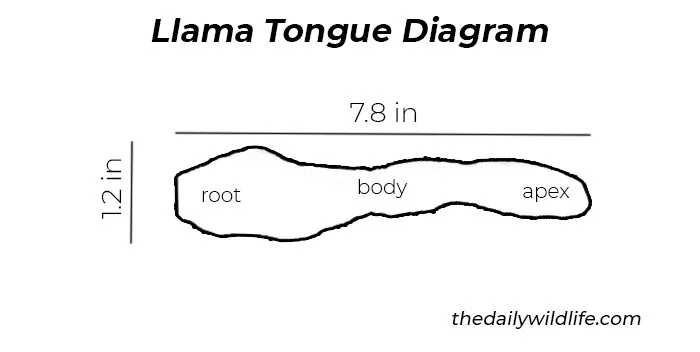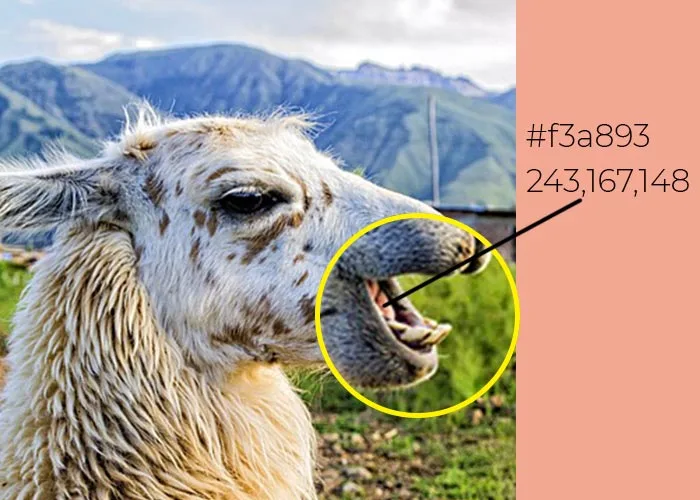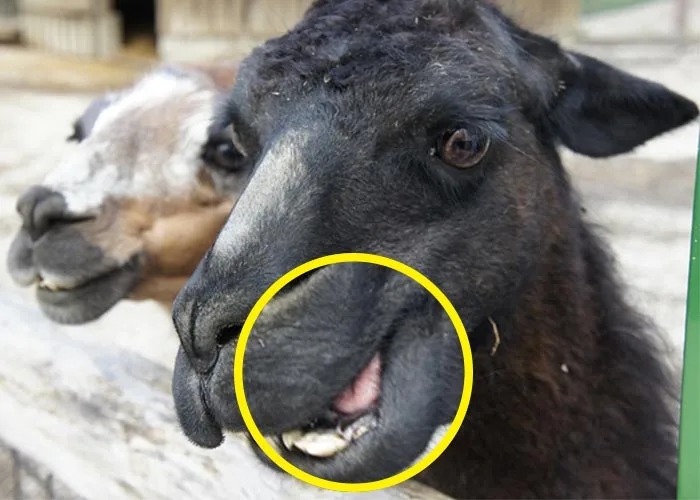In animals, the tongue plays an important role in everyday life. Some use their tongues to clean themselves, some to grab their food, and others to manipulate the food in their mouths. Some even use their tongue to smell their environment.
The tongue of a llama does none of that.
That doesn’t mean that a llama’s tongue is completely useless. Not at all.
In this article, you will learn:
- If llamas have tongues (the answer is pretty obvious by now, no?)
- Its basic anatomy
- The color of a llama tongue
- How long the tongue is
- And main llama tongue diseases

Table of Contents
Do Llamas Have Tongues?
Yes, llamas do have tongues. A llama’s tongue is a muscular organ located in the mouth of the animal. It is covered in four types of lingual papillae that allow the llama to taste its food. These are filiform, fungiform, lenticular, and circumvallate papillae.
Unlike other animals, llamas do not use their tongue to manipulate food. The tongue is not very mobile.
It consists of three parts:
- Apex
- Body
- Root
The main function of a llama’s tongue is the tasting function which plays an important role in selecting nutrients. It also has the purpose of guiding the food towards the throat and esophagus for further digestion.
The tongue is covered with keratinized conical structures called papillae. As mentioned, llamas have four types of papillae on their tongues.
Those four have two functions: mechanical and chemical/gustatory. Filiform papillae have a mechanical role whereas fungiform, lenticular, and circumvallate papillae perform a gustatory one; they allow llama to taste the food it’s eating.
In llamas, each fungiform papilla is smooth and convex and has numerous taste pores. The tongue is covered by many large mechanical papillae, including both lenticular and filiform types. They are used to protect the tongue from harsh, dried, and fibrous plants and to direct the food towards the digestive tract.
Llamas (Lama Glama) are both grazers and browsers. They prefer to eat large quantities of coarse bunchgrasses and they also browse available shrubs and trees. Usually, they will eat food that is extremely hard to digest. Thanks to their stomach with three compartments, llamas digest all of those plants easily.
They are not picky eaters and will use their flexible upper lip, rather than a broadly sweeping tongue, to get to the preferred food and grab it.
Llamas are social animals that communicate with other members of the herd by humming. If a llama is mildly agitated, it will emit a snort with a short burst of air through the mouth or make a clicking sound with its tongue to express its discontent.
How Long Is A Llama’s Tongue?
A llama has a tongue length of around 7.8 inches (20 cm). It is 1.2 inches (3 cm) wide and 0.8 inches (2 cm) tall in the front two-thirds. The back part (its last third) has a pronounced dome that is around 2 inches (5 cm) tall.
The tongue of the alpaca is around 5.5 inches (14 cm) in length. It is around 0.7-1 inch (1.8-2.6 cm) wide.
As a comparison, a llama’s cousin, the camel, has a tongue around 17 inches (43 cm) long.
Here’s what a llama’s tongue diagram looks like.

And here’s a comparison table between tongue sizes of llamas, alpacas, and camels.
| Animal | Tongue length |
| Llama | 7.8 inches (20 cm) |
| Alpaca | 5.5 inches (14 cm) |
| Camel | 17 inches (43 cm) |
Further reading: Llama’s closest relatives
What Tongue Color Do Llamas Have?
Similar to camels, the color of a llama’s tongue is pink.
For example, this llama has a HEX value of #f3a893 and an RGB value of (243,167,148) of its tongue.
Here’s the color of a llama’s tongue.

Read more: What color and wool patterns can llamas have?
Why Do Llamas Stick Their Tongue Out?
When one llama is annoyed with another llama, it will stick its tongue out to express its displeasure. If the conflict escalates, they might spit, wrestle with their necks, or bite one another.
However, a llama will rarely protrude its tongue from the mouth. The tongue is short, and the mouth is not as flexible as it is in other animals, for example, a camel. A llama’s mouth does not open too widely.
Maybe owners taught their llamas that sticking their tongues out is rude, and that’s why they keep their tongues inside their mouths.
Can Llamas Lick?
A llama has a relatively immobile tongue that gets rarely extended beyond the lips and does not participate in food grabbing. Because it rarely protrudes from the mouth, llamas do not, as a rule, lick themselves, their young, or salt blocks. The new mother does not remove the placenta or lick the newborn.
Some llamas may lick at a salt block long enough to obtain some supplement, but usually, llamas will chew at the salt block rather than lick it.

Llama Tongue Diseases
Llamas do not have too many specific diseases of their tongue. They might suffer from tongue inflammation, occasional tongue lacerations, or different nerve paralysis.
Glossitis, a problem where the tongue is swollen and inflamed, may be part of general stomatitis. Stomatitis is a condition characterized by the irritation and inflammation of the soft tissues inside your llama’s mouth.
A llama will rarely lacerate its tongue as it rarely protrudes from the mouth. Occasionally, if a llama falls on its head while running away from an aggressive herd member, it might cut its tongue on the canines or the incisor teeth.
Sometimes, a veterinarian might injure the animal’s tongue by pulling it too much when inserting an endotracheal tube.
Paralysis of the tongue might sometimes be a part of hypoglossal nerve paralysis. It might be a result of a fracture of the jaw or neck bone, abscesses at the base of the tongue, or lesions in the brain (encephalitis, rabies, tumor).
In the western parts of the USA, foxtails are a big issue for llamas. These widespread grasses may get stuck alongside the tongue and in the oral cavity. Because llamas do not have a very flexible tongue, they will not be able to clear the foxtails from their mouths properly.
The awns may penetrate the mucous membranes of the tongue, causing ulcers and swelling.
Diagnosis
To establish a tongue disorder, a veterinarian or an owner will need to physically examine the animal. If a llama has tongue paralysis, a closer inspection is required to determine the cause. That usually involves a neurologic examination and evaluation.
If a llama cannot swallow, one of the reasons might be a lesion on the tongue.
Treatment
A veterinarian should stitch up wounds and incisions with a suture. In many cases that will probably require general anesthesia.
In other cases, veterinarians and experts recommend general nursing care.
Llama Tongue Video
And here’s a funny video of a llama sticking its tongue out. The video quality is bad but notice the tongue color.
5 Llama Tongue Facts
- A llama’s tongue is around 7.8 inches (20 cm) long and 1.2 inches (3 cm) wide.
- Llamas do not have very flexible tongues and will rarely stick their tongues out of their mouths.
- But when they do, a tongue sticking out usually means that a llama is mad at another llama; that’s how they express their discontent.
- A llama has a tongue that is usually of pink color.
- Because they do not protrude their tongue too much, llamas rarely lick salt blocks, themselves, or their young.
Want to see funny jokes, one-liners, and llama memes? Here’s a meme article you need to check.
Final Thoughts
This concludes our article on the llama tongue. In this article, we explained if llamas had a tongue and gave its basic anatomy. We also showcased the size of the llama’s tongue and compared it to alpaca’s and camel’s tongues.
Because their tongues are not very long and flexible, llamas will not protrude them too much outside their mouths. Sometimes, you should closely inspect your llama’s tongue and mouth, as the animal might be suffering from some tongue disorder.
References
[1] Fowler, Murray. Medicine and surgery of camelids. John Wiley & Sons, 2011.
[2] Erdoğan, Serkan, Silvia Villar Arias, and William Pérez. “Morphofunctional structure of the lingual papillae in three species of South American Camelids: alpaca, guanaco, and llama.” Microscopy research and technique 79.2 (2016): 61-71.
[3] Cebra, Chris, et al. Llama and alpaca care. Elsevier Health Sciences, 2014.